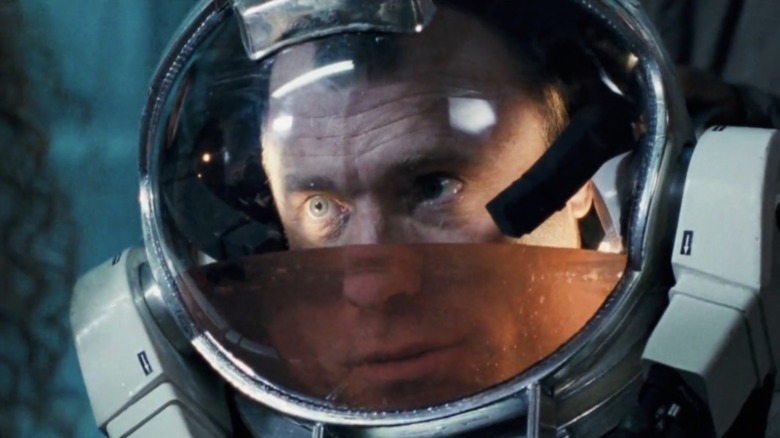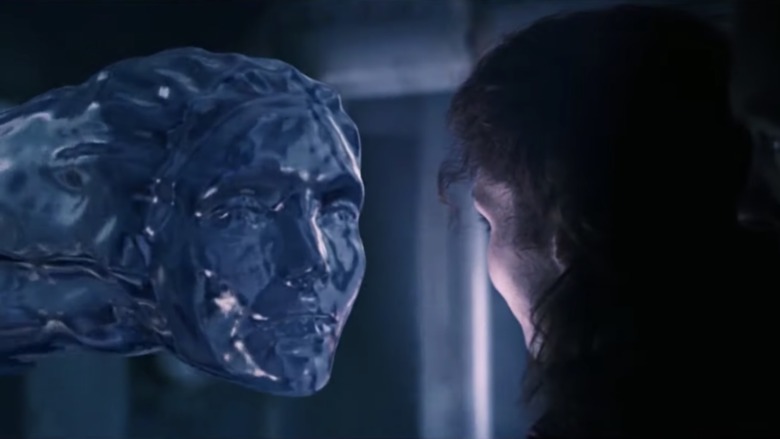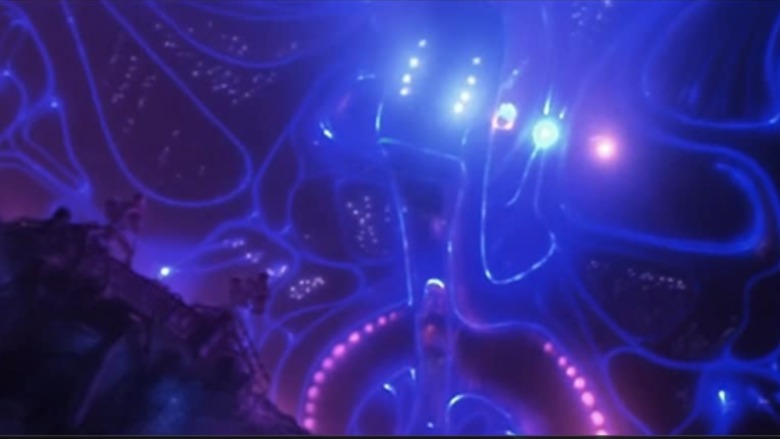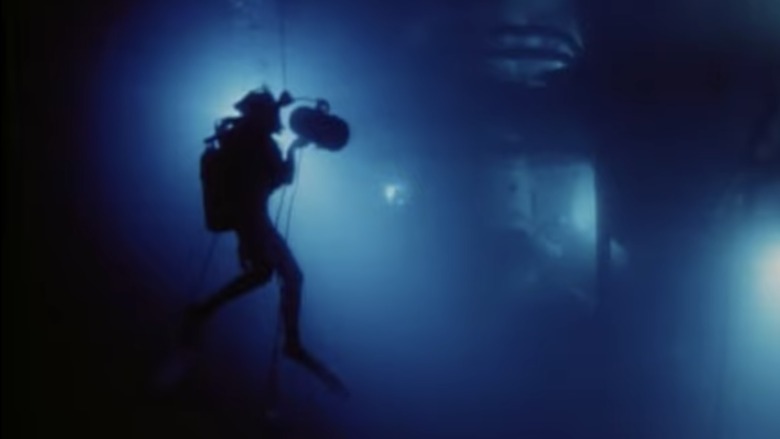The James Cameron Movie That Was Actually Filmed Underwater
Back in 1989, James Cameron made a groundbreaking movie called The Abyss. It starred Ed Harris, Mary Elizabeth Mastrantonio, and Michael Biehn in a story in which a U.S. nuclear submarine crashes, leading a Navy SEAL recovery team to ally with the crew of an experimental, submersible oil rig called Deep Core to beat the Soviets to the U.S.S. Montana. The oil rig crew discovers a non-terrestrial intelligence (NTI) during an initial investigation. To make matters worse, they get cut off from their surface support due to a hurricane that knocks a cable crane over, dragging the rig to the edge of a huge trench, partially flooding its interior and killing members of the crew. The separate teams soon find that their goals are at odds with one another when some the SEALS bring aboard a nuclear Trident missile warhead salvaged from the sub — and want to nuke the NTIs.
In its review from the time, The Hollywood Reporter said, "Colossally ambitious, this logistically boggling and technically brilliant film from writer-director James Cameron is a visual tour de force, featuring overall, the greatest underwater sequences ever seen on film." It called the movie "a masterwork," noting that the actors "all deserve weeks on the beach after this demanding underwater film (or probably weeks on an oasis as far from the ocean as possible)."
The publication wasn't wrong: the filming of the movie was notoriously difficult, but the results were amazing, at least for the time. The Atlantic reports that the film made more money than The Terminator and almost as much as Aliens when it came out in theaters. Yet, it's not remembered as well as some of Cameron's other works — even though it was actually filmed more than 30 feet underwater.
All the underwater scenes were actually shot underwater
In the documentary Under Pressure: The Making of The Abyss, Cameron explains his goal: "If I couldn't do what 2001: A Space Odyssey did for science fiction films taking place in space, if I didn't feel that I could do that in the underwater arena, then I didn't want to make the movie," he said.
To that end, he decided to make the film as real as possible, setting the underwater scenes of the film at the abandoned Cherokee Nuclear Power Plant facility in Gaffney, South Carolina, with a giant main reactor (holding 7.5 million gallons of water) that serves as the abyss of the title. In fact, Deep Core became the largest underwater set ever built, complete with real submersibles and other underwater machines, plus two giant tanks (the second held another 2.5 million gallons of water).
SyFy, in a 30-year-retrospective of The Abyss, reports that 40 percent of the movie's principal photography took place underwater. All those scenes in which the actors are swimming and diving? Those were real. The actors had to master hardhat diving as part of the shoot and their gear wasn't made up of props, but actual life support, according to producer Gale Ann Hurd — and that was just the tip of the iceberg. Diving suits were made especially for the cast (to light faces and record dialogue), while black beads on the water's surface and a gigantic tarp were used to block out sunlight without obstructing access to the water's surface. Side effects of exposure to bleach used to change one of the tanks' pH balance (like skin and hair getting bleached and falling out) became common. And the production went over budget and behind schedule.
Both James Cameron and Ed Harris nearly drowned on set
It's been well publicized in the years since The Abyss' release that the actors, and James Cameron himself, did not always have a good time on set. Cameron (as related in the book James Cameron: Interviews) almost died underwater when his oxygen ran out. A safety diver came over with a faulty regulator, causing Cameron to suck in water instead of air — and, not realizing the producer's true plight, wouldn't leave him until punched.
Ed Harris also almost drowned while on set. It happened during one of the final, climactic scenes in the movie, which his character, Virgil "Bud" Brigman, descends into the bottom of the giant abyss following a climactic submersible battle between himself and ex-wife Dr. Lindsey Brigman (Mastrantonio), against Lt. Hiram Coffey (Biehn). Despite barely winning that conflict, the primed warhead sinks to the bottom, and Bud must go get it, using an experimental technology that allows him to breathe fluid underwater.
In real life, Harris ran out of air during that sequence. Someone finally came over to give him oxygen — but had the regulator upside down, resulting in Harris taking in water with the air. Finally, the cameraman came over to right the apparatus, allowing Harris to get the air he needed and swim up to the top. "But I remember driving home that night, and I just broke down, I was just weeping," Harris relates in the documentary. "Because there was a part of me that was really disappointed in myself for not being able to do this thing, and there was also a part of me, it was like I just didn't know what to do, I didn't know what I was supposed to do...I really thought I was going to die for a second, and it really pissed me off that I was afraid of that, that I got scared of that for a second."
Not to mention, he still had to get back in that liquid-breathing suit for more days of filming.
The trauma of the shoot affected everyone, but it remains a great piece of cinema
Mary Elizabeth Mastrantonio has been famously quoted as saying, "The Abyss was a lot of things, fun to make is not one of them." In a scene where Bud and the others try to revive her after she has drowned, Harris told Entertainment Weekly that he screamed at Mastriantonio's prone body to wake up, slapping her across the face even though he noticed the camera trained on them was out of film. "And Mary Elizabeth stood up and said, 'We are not animals!' and walked off the set," Harris said. "They were going to let me just keep slapping her around!"
Biehn told the Orlando Sentinel that he also experienced a moment of panic on set. "I was 30 feet underwater and suddenly the lights went out," he said. "It was so black I couldn't see my hand. I couldn't surface. I realized I might not get out of there." They weren't the only cast and crew members pushed to their limits by the grueling shoot, which required cast and crew to stay 30 feet or more underwater up to five hours a day.
Bad feelings reigned after these horrible conditions, even after the shoot ended. The media reported that Harris refused to talk about the film for some time afterward. Mastrantonio declined to do publicity. The tension between the three leads and Cameron — who apparently expressed only limited sympathy for them during the following promo tour — was described as "explosive" in a retrospective from The Guardian. Yet, despite all the emotional breakdowns and untenable conditions, one could argue that Cameron's insistence on imitating reality stood the film in good stead. It remains a classic, one that Looper calls "James Cameron's best movie."



